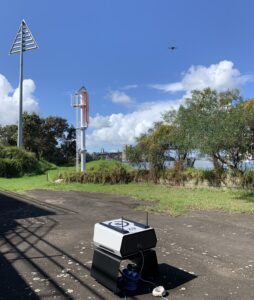
by DRONELIFE Staff Writer Ian M. Crosby
From Sydney Harbour’s Goat Island, an AI enabled drone launched from a docking station, maneuvering around buildings and pylons before detecting the Harbour Bridge in the foreground.
Continue reading below, or listen:
This marked the first occasion in which the Skydio Dock, an ultra smart docking station, had been deployed in Australia. The launch was carried out by US drone manufacturer Skydio, alongside Australian RPAS training leader Aviassist, as part of the Sydney Dialogue summit demonstrating new technologies.
The Skydio Dock is capable of flying a drone in a five kilometer range and to within 11 centimeters of a foreign object, resulting in increased efficiency within industries such as agriculture, mining and transport. Although not required, an individual can monitor the drone’s stream remotely from anywhere in the world.
“It was only a matter of time,” said Aviassist’s Ross Anderson. “The drone was able to work out there were certain structures in the area and fly around them. It’s not autopilot, it’s AI. It was the drone summing up its surroundings and saying to itself, ‘hey, I can fly here, I can’t fly there’.”
AI enabled drones are expected to have nearly limitless potential applications. Skydio already has clients within the transport and mining sectors, as well as the ADF.
“AI enabled drones will be seen as teammates, not tools,” Anderson says. “A great example is bridge and infrastructure inspections – it’s dangerous for someone to be climbing that high up and even with drones being flown by someone on the ground, they’re always prone to crashing as a result of human error. A drone that can fly itself would make less mistakes than a person and that raises the safety bar.”
“In the event of a car crash, an AI enabled drone could quickly fly over and survey the scene and relay critical information to first responders as they do their much more important job, which is helping the people involved,” Anderson continued. “Drones have been flown remotely and beyond visual line of sight for a while but this takes it to the next level.”
Read more:
- Skydio Partners with gNext for Drone Infrastructure Inspection
- Skydio Funding: $230 Million to Expand U.S. Manufacturing, Hiring
- Skydio Introduces Skydio Dock and Dock Lite: Small, Lightweight Solutions for Remote Drone Ops
- New Skydio App Features Announced: New Camera Controls, Panoramas, and More
- Skydio Responds to Hurricane Ian: Free 24/7 Emergency Support Hotline and More for Customers Involved in Recovery
Ian attended Dominican University of California, where he received a BA in English in 2019. With a lifelong passion for writing and storytelling and a keen interest in technology, he is now contributing to DroneLife as a staff writer.

Miriam McNabb is the Editor-in-Chief of DRONELIFE and CEO of JobForDrones, a professional drone services marketplace, and a fascinated observer of the emerging drone industry and the regulatory environment for drones. Miriam has penned over 3,000 articles focused on the commercial drone space and is an international speaker and recognized figure in the industry. Miriam has a degree from the University of Chicago and over 20 years of experience in high tech sales and marketing for new technologies.
For drone industry consulting or writing, Email Miriam.
TWITTER:@spaldingbarker
Subscribe to DroneLife here.